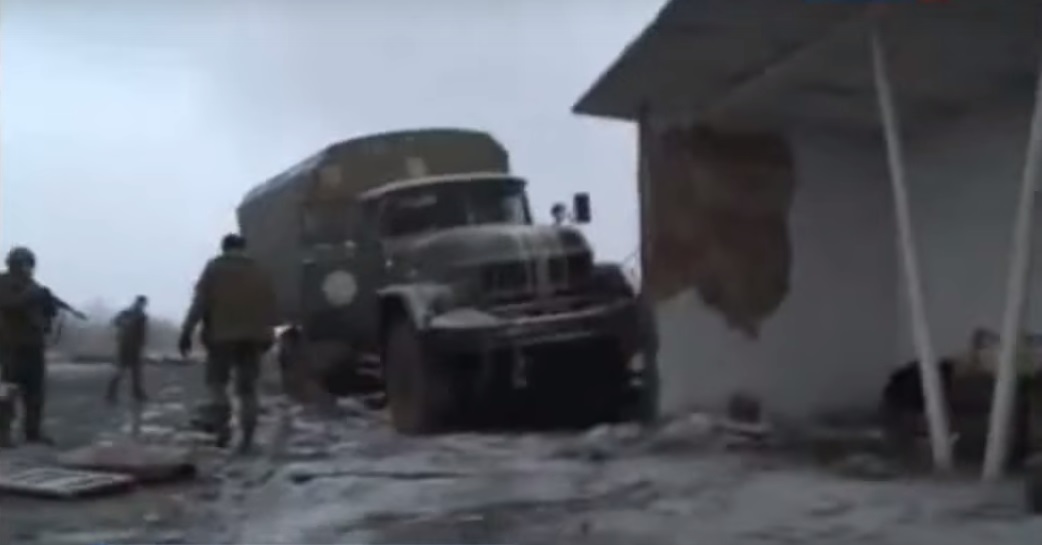Russian Regulars Take the Lead
Starting from 1 February 2015, Russian-led “Separatist” forces began their covert operation to capture the М-03 main supply route (MSR) connecting the cities of Debaltseve and Artemivsk. Previously, they had managed to wrest back the key Ukrainian stronghold of Vuhlegirsk on our western flank. In order to suppress Ukrainian military capabilities they advanced their artillery and began bombarding the road daily making safe transit impossible. As a result, from early February this corridor had been closed to civil traffic. However, enemy shelling was rather random and intimidating, so Ukrainian armored vehicles still had a chance to drive back and forth without significant loss.
With the fall of Vuhlegirsk our western flank developed a dangerous hole. Our situation was becoming critical because no significant resources remained to safeguard M-03. Moreover, the frozen and snowy terrain covered with ravines, streams and small forests permitted enemy vehicles and tanks to advance unspotted and fast. My observations were confirmed later on August by Col. Gen. Victor Muzhenko (head of the General Staff at that time) who said for the Mirror of the Week newspaper that Ukrainian forces had left with only a tiny post with a lonely armored vehicle on that road near Lohvynove.
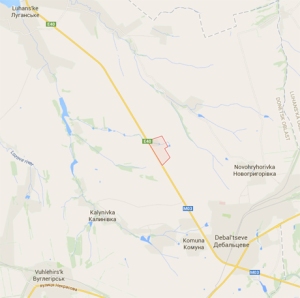
It is known for sure that around 5am on February 9, 2015 (after a week of preliminary bombardments) the first armored unit of the separatist so-called Donetsk People’s Republic made for Lohvynove. This unit blocked the MSR with anti-tank mines and wood logs.
Four Ukrainian servicemen who were stationed there on a monitoring mission did not open fire to deter the enemy forces and quickly ran away however reporting to the high command about this enemy advance.
As it is well known from the Russian newspaper Novaya Gazeta, the village of Lohvynove and M-03 road were first captured by a squad of some 30 fighters, 90 per cent of whom were experienced mercenaries from the Russian Federation, led by a Russian military officer, Serhey Petrovsky. Open-source data suggests the Russian 52 Spetsnaz Regiment was responsible to aid attacks on both Vuhlehirsk and Lohvynove. Russian state media rushed two TV crews to film this success and spread the propaganda message that “local separatists have closed the lid on the Debaltseve boiler” all on their own. Actually the rag-tag miners with Russian sentiments who live in Donbas region had done no such thing: the camouflaged Russians cut the road, so their media statements were obvously false. After the propaganda footage was filmed, the Russians quit Lohvynove leaving local armed men and volunteer Cossacks (from Russia’s Don region) to guard the road. Meanwhile, regular Russian forces, including tanks of the 5th Brigade (hailing from Ulan-Ude in Russia’s Buriatia region), were hurrying up to Lohvynove via the newly created hole.
For six hours in a row, our Sector “C” HQ did not warn Ukrainian troops inside Debaltseve that the major road had been cut. First I heard about this strange delay from our battalion’s Col. Ihor Shcherbyna who visited the HQ early that morning (for more on him, please read my other blog posts). Now I could only assume that our high command was talking to Kyiv and trying not to create panic among 2,600 de-facto-encircled troops of mostly inexperienced reservists. Probably, the high commanders sought solid confirmation from intelligence and they lacked this at the time. So every hour of such a delay with instructions took away more and more lives of the unaware Ukrainian servicemen, law enforcement agents, paramedics, etc. During the entire morning of February 9th the enemy easily picked off them stranded on the road, as well as captured those wounded or surrendered.
Ambush By The Road
That February 9th morning was foggy and frosty on the outskirts of Debaltseve. Visibility on the narrow two-lanes ice-bound M-03 road—hidden between forests and hills—was down to just 100 metres. Military radio communications were unstable between Debaltseve city and Myronivske settlement controlled by the Ukraine government forces on the north west, while the civil cell-phone transmitters inside the city had been destroyed. The military and service convoys were still using the supply road and approaching the captured village being blind, deaf, and unaware that they were entering a trap from which there was little hope of escape. This way the six long hours of slaughter had begun …
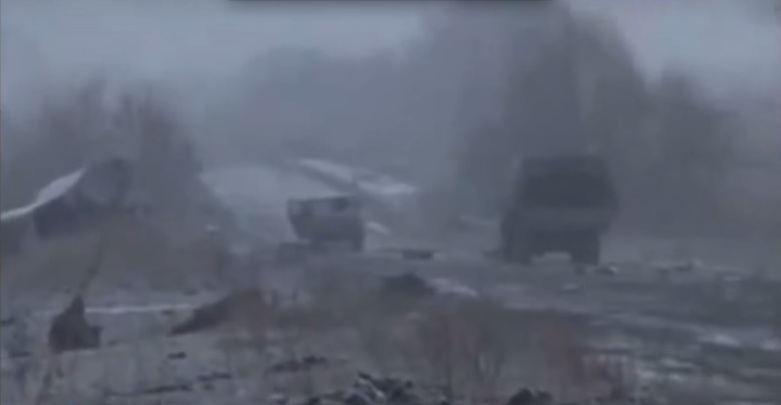
During the first hour, four servicemen from 128 Brigade’s rocket-artillery squadron were killed on the road at Lohvynove village. Their Soviet-made old ZiL and URAL trucks, loaded with ammunition, were stopped by rifle fire. Those people were driving from remote Artemivsk ammunition depot and did make just 5 kilometres to their base. Among those killed were the commanders of two artillery units Major Alex Hurtov and Sr. Lt. Vasyl Bilak with the drivers Sgt. Roman Chornobai and Soldier Roman Sovlych. As a result, during last days of siege Ukrainians did not get so much needed resupply of mortar shells and MLRS rockets because previous ten days the artillery duels around Debaltseve drained their resources. That is why our artillery men began responding to our requests for fire support saying that they can lob only a couple of shells on newly discovered enemy targets…
The next road tragedy to hit the Ukrainian Army was the execution of four high-ranking officers, who were carrying classified General Staff documents and secret radio equipment in their jeep. At 5am they left the city of Artemivsk and—already shrouded in a communication black-out—drove 60 kilometres down to their deaths. High speed can bestow a high chance of survival during random bombardments, but terrorists ambushed them and shot up their speedy vehicle right in front of the video cameras. At the last moment the driver, Srt. Junor A. Makarenko, slammed the steering wheel hard right to avoid mines, dispersed on the road, but the car drove into a ditch with Col. Ihor Pavlov (a tutor at the military college of Kyiv Technical University), Lt. Col. Arthur Muzyka (from the Communications Department of the General Army Staff), as well as Col. Serhyi Tsyganok and Major Sviatoslav Vasylenko (both from 330 Army Postal Unit).
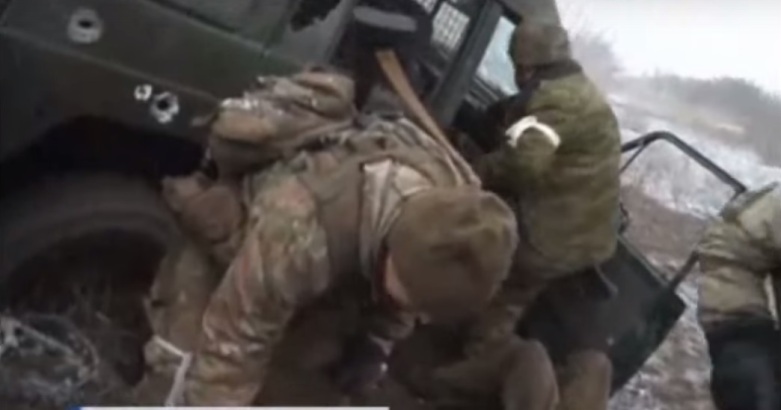
Prior to this, 47-year-old Col. Pavlov had been appointed 1st Deputy to the Chief of the entire Anti-Terror Operation. The masked Russian commander of the so-called Donetsk People’s Republic armed unit proudly posed before the TV cameras with the Colonel’s ID and a copy of his promotion order.
The video footage of a outrageous crime — terrorizing the wounded Ukrainian officers Pavlov and Tsyganok on the Ukrainian soil in Lohvynove was openly published by the Russian media on YouTube and was there for a long time. On that video they were searched, beaten, kicked with boots, and intimidated. However, on the video dying Col. Pavlov responded “You will yet pay for everything!” to the masked fighter who spoke with a deliberate Russian accent and pointed a Kalashnikov rifle at Pavlov’s chest threatening execution.
Russian TV or online media did not publish the exact moment of execution of those five captured at Lohvynove most likely avoiding sharing the proof of a war crime. But all above mentioned Ukrainians were later returned to Ukrainian authorities dead. so I can assume that murders may indeed happened that morning by the road in Lohvynove village, or in nearby locations where Ukrainian captives might be moved for interrogation and then left to die. In March, pro-Russian separatists released the corpses of three of the above-mentioned officers. Later the corpses of Vasylenko and Makarenko were also discovered. In this context, I should emphasize that according to information, photographs, and videos published by different anonymous Russian bloggers the armed fighters on the side of Donetsk People’s Republic demonstrated that the are barbarians.
The next Ukrainian officer to be killed on M-03 that morning was Major Mykyta Nedovodiev from the Kyiv-based 101 Brigade of military police. At 8am he and a soldier Vadym Fedorchenko left Debaltseve in a KamAZ truck driving to Kharkiv. There is no info on the circumstances of their death. I can only assume they got ambushed on the road the same way as the others. A Russian photographer Max Avdeev—who, on 17 February, published on BuzzFeed photos from captured Lohvynove—saw many wrecked and burned-out trucks in the area one of which was allegedly Nedovodiev’s KamAZ.
At least 8 servicemen of 30 Brigade (from the town of Novo-Volynsk, Zhytomyr region) became the next victims of the Kalashnikov-toting masked fighters hunting Ukrainians on the road. In two trucks, the eight Ukrainians left Debaltseve and soon got trapped in the ambush. Forty-year-old Sr. Lt. Serhyi Romanchuk (a volunteer of the first draft due to be discharged in 2 weeks), 42-year-old Sgt. Serhyi Sukhenko, and 34-year-old soldier Serhyi Lialevych were killed at once. Three others—43-year-old APC commander Vasyl Demchuk, Sgt. Pavlo Platsynskyi (who celebrated his 37th birthday the day before) and 34-year-old soldier Alex Berdes—were captured and executed. Their execution was filmed on video and uploaded to the Web but later removed. The murderers buried two of the corpses near the village but the devastated body of Demchuk—with smashed head and minus an ear—was later found in a Donetsk mortuary. The 45-year-old Sr. Sgt. Yevhen Korota (a volunteer of the third draft), and 36-year-old soldier Vitalyi Katishov were allegedly killed in the other ZiL truck. However, at the mourning ceremony Korota’s friend Alex Klymchuk told the local Kyiv newspaper that he died not on February 9 but three days later.
Inconsistencies surrounding the dates of deaths of servicemen are common during wars, especially in rapidly developing operations such as a siege Debaltseve. It is obviously hard to quickly verify and count daily losses.
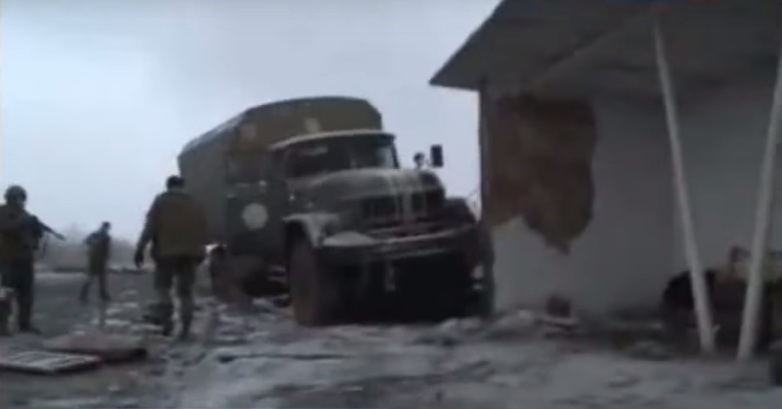
Unfortunately, that tragic morning also took lives of 6 Ukrainian paramedics. Initially, an ambulance of Khmenitsky Medic Squadron drove over a mine while taking incoming fire which killed soldiers Anatolyi Sulyma, 48 and Mykhailo Baliuk, 25. Colleagues later clarified that they were tragically wounded to necks and heads.
As soon as communication with Sulyma and Baliuk was lost, the next group of the Ukrainian paramedics rushed to the rescue — they represented 1st Pyrohov Medical Squadron of the National Guard from Lviv. The group knew that the road was currently under bombardment, but they were unaware of the enemy ambush. In a jeep with an APC following them behind, they drove fast over 55 kilometres south looking for wounded or stranded. But at the entrance to Lohvynove their jeep drove over a land mine and exploded, wounding Cpt. Taras Konchevych, a soldier Vasyl Zadorozhnyi, 50 and two paramedics Dmytro Lahunov, 49 and Maxim Ovcharuk, 49. Those in the APC behind opened fire at the ambush, successfully liquidating one enemy fighter, but the following mortar bombardment forced them to turn around and retreat back to Artemivsk, leaving injured comrades in the ditch by the road.
Supply Routes are Blocked
Around 10am, the thick fog over Lohvynove lifted. No further Ukrainian units were approaching the village via M-03, and everything around fell silent. The bodies of Ukrainian servicemen were lying in ditches on both sides of the MSR, and their wrecked trucks were still smoking. Thus, the Russian mercenaries of the so-called “DNR” fully enjoyed their revenge on the “fascists”—as the Kremlin propaganda machine calls Ukrainian government troops—and retreated with their video fixers.
After the Russian squad departed, local “Separatists” and Russian Don Cossacks began collecting the corpses and building defence lines around the captured village. They were waiting for ammo trucks, as well as dozens of tanks, recently relocated from Russia (quite candidly). Inside the concrete pavilion, under a big “Lohvynove” sign at the bus stop on M-03, the fighters breakfasted on food lifted from the Ukrainian military vehicles: salads, bread, lard, fish and meat preserves, cookies, candies, etc. A couple of wounded rebels needed first aid and asked a woman in filthy clothes to give them anaesthesia shots: “I didn’t bring anything like that. You told me we were just going to check this area!” she replied to the wounded, appearing to be an inhabitant of the village who had guided them in.
At 11am, 2,600 Ukrainian troops inside Debaltseve finally got a radio warning from C Sector HQ: “Stop using the M-03! It’s allegedly blocked. Limit your radio conversations, because it’s suspected that radio devices are captured. Block or re-code any lost devices.” The “Separatists”, enjoying their breakfast at the bus stop in Lohvynove, heard this warning and joyfully realized they had time to build their stronghold: Ukrainian troops would not be able to counter-attack for the next few days.
Our People Got Into Trouble Too
By some unexplained circumstance, a group of four servicemen from my 40 Battalion, along with the deputy commander, Lt. Col. Volodymyr Sarychev, who were going to Artemivsk that morning, were not warned. Around 10:30am they drove out of our main camp at Debaltseve in a UAZ Patriot jeep and joined the M-03. Communication with them was soon lost. The relaxed after eating captured food from the stopped Ukrainian vehicles separatists didn’t kill them but sent them as POWs to the occupied city of Luhansk.
C Sector HQ, the Anti-Terror Operation, and the General Staff urgently needed accurate data on enemy forces in Lohvynove. But military intelligence structures in the Debaltseve area didn’t work as fast or as reliably as they should; which was later confirmed by the head of the General Staff, Colonel-General Viktor Muzhenko, on 29 August, in his interview for Mirror of the Week: “We didn’t possess clear information that time from our intelligence. We changed the chief of Head Intelligence Department, because we didn’t receive enough volumes of required data.” This explains why the Ukrainian Army immediately sent a small reconnaissance unit to Lohvynove, led by the brave Senior Lieutenant Volodymyr Hryniuk with four servicemen from 30 and 54 Battalions: “Our commander [Hryniuk] described that operation as ‘a walk’, but we were returning from there under heavy bombardments,” recalled a soldier nicknamed “Hibbon” for the Censor News website on 14 October.
The shelling of Lohvynove on 9 February was not only carried out by “Separatist” forces, but Ukrainian artillery too. After receiving authenticated info from the reconnaissance unit, Ukrainian artillerists conducted two massive bombardments of Lohvynove and Vuhlehirsk, in order to destroy enemies and prevent their reinforcement.
It was interesting for me to watch the work of the artillery (when it didn’t target us, of course). On the evening of 9 February, in complete darkness, I observed the shelling of Lohvynove from the roof of my battalion camp in Debaltseve: flashes and loud explosions on the northern horizon; 20–30 seconds between flash and explosion indicated a distance of 7–9 kilometres—and Lohvynove was indeed located at such a distance from us. However, bombardments caused only partial losses among the enemy troops, several of which were forced to relocate, as reported next day by a coordinator of the Information Resistance volunteer group (and member of the Ukrainian Parliament), Dmytro Tymchuk.
Meanwhile, at Debaltseve, Kramatorsk and Kyiv, generals and colonels were designing the “A Plan” for regaining control of Lohvynove, and looking for reserves to carry the plan into action. There was no hope of finding reserves within the blockaded Debaltseve formation of 2,600 personnel, because this would weaken the flanks of the defence line, through which “diversion groups” of masked Russian regulars were already infiltrating.
On 29 August, in his interview for the Mirror of The Week, the head of the General Staff, General Victor Muzhenko, said that the Ukrainian Army did not really have mobile reserves: there was a battalion from 30 Infantry Brigade (which had just finished a tough assignment at Donetsk airport); a unit from 1 Battalion/79 Airborne Brigade; a unit from 95 Airborne Brigade; and the tanks of 1 Tank Brigade. Consequently, a couple of squadrons from 30 Brigade were immediately sent to the village of Luhanske: one travelled in its own vehicles, while the other arrived by cargo train. Due to cooperation in the ATO, the National Guard offered its Donbas Battalion … but just a small part of it.
While developing the “A Plan” in Kyiv, General Muzhenko started to think about a “B Plan”—how to withdraw Ukrainian troops from the encirclement. But politics got in the way. Muzhenko faced global interests, not only the loss of men, territory, and the strategic railway hub at Debaltseve. And so the decision was made in Kyiv to postpone the retreat from Debaltseve until another round of peace negotiations between the leaders of Ukraine, Germany, France and Russia, due to be conducted at Minsk on 12 February. There was an idea not to let Putin “save face” on the global arena by prematurely abandoning Debaltseve, because he definitely wanted to capture this town at all costs.
The “A” and “B” plans were interconnected. The success of the second fully depended on the success of the first. During the coming week, Ukrainian commanders should seek to secure all roads, tracks and footpaths around Lohvynove, in order quickly and safely to withdraw as many troops and vehicles as possible. It is easy, however, to design combat operations on a map—and much tougher to design them under heavy international pressure, during an unprecedented offensive along the front line, and realize them effectively using exhausted troops with no reserves or proper intelligence data.
Following the bombardment of enemies in Lohvynove, the morning of 10 February seemed to give the Ukrainian Army hope that a full encirclement of Debaltseve could be avoided. The Ministry of Defence even shared a carefully worded message to calm things down: “The direction of road between Debaltseve and Artemivsk has been de-blocked.” Usually, an inattentive mass audience does not appreciate the true context of messages used in PsyOps. But those who know such methods realized the MoD did not actually say that M-03 and Lohvynove were now free …
In fact, the enemy fighters were getting ammo resupply, more units (mostly Russian regulars and mercenaries), APCs and tanks, which they placed in the hills around the village. Under the professional guidance of their Russian instructors, “Separatists” were digging trenches, setting ambushes, and building a stronghold to paralyze any Ukrainian convoy. And so our enemies did not disappear from Lohvynove: they disseminated towards neighbouring Nyzhne Lozove and Novohryhorivka villages, in order to widen their sector of fire: “Roads were mined. Any de-blocking did not happen,” said Ukrainian MP and former commander of the Donbas Battalion, Semen Semenchenko, on his Facebook page on 10 February.
The seriousness of the situation around Lohvynove was proven the same day. Around 3pm, vehicles carrying police chiefs of the Donetsk and Lviv regions were caught in an ambush, while trying to escape from Debaltseve. One of their vehicles was blown up by a mine, killing Dmytro Ternovyi, security chief of the Donetsk railway. Two other officers—Dmytro Zagaria (head of the Lviv region police) and Ihor Volskyi (commander of the Lviv Battalion)—were wounded and engaged in combat. They were rescued a couple of hours later, but they left the body of their comrade in the snowy fields. “Separatists” released it on 21 February.
(Updated on October 5, 2020)
